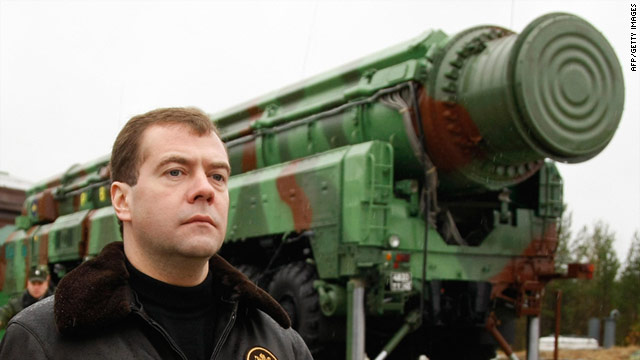
The US Threat Dominates Russian Defense Spending and Foreign Policy Decisions
Publication: Eurasia Daily Monitor Volume: 8 Issue: 29
By:

Verbal confrontation between Moscow and Washington has decreased somewhat as during the 47th International Security Conference in Munich last week. During the conference, Russian Foreign Minister, Sergei Lavrov, and the US Secretary of State, Hillary Clinton, exchanged instruments of ratification which enabled the START III treaty to come into force. But this apparent success in the “reset” policy does not seem to have removed the underlying differences between East and West (Kommersant, February 7).
The perceived US military and political threat clearly overwhelms strategic planners in Moscow and a convincing military deterrent is seen as the only credible answer. In Barack Obama’s White House, the START III treaty may be seen as an instrument to establish enduring trust and cooperation on sensitive issues with Russia. In Moscow START III is viewed as essentially a technical agreement to preserve a credible nuclear deterrent against the US by forcing the Pentagon to downsize its nuclear arsenal to help Russia maintain a balance and contain a dangerous opponent. During ratification procedures in the Duma, Defense Minister, Anatoliy Serdyukov, announced: “It is a very useful treaty –it allows us to significantly increase our [nuclear] armaments, while the Americans will have to cut theirs” (Interfax, December 24, 2010).
START III is only part of the evolving strategy to keep the US at bay. Last December President Dmitry Medvedev ordered Serdyukov and Prime Minister, Vladimir Putin, to organize a new joint air-space defense strategic command by merging existing antiaircraft and ballistic missile defense (BMD) units with the early warning system and space control assets. The new branch of the military (vozdushno kosmicheskaya oborona –VKO) must become operational by December 1, 2011 (RIA Novosti, December 7).
The Russian Air Force will offer its existing 13 VKO brigades that combine antiaircraft guided missile regiments with radar regiments. These VKO brigades are in essence the remnants of the massive Cold War era Russian Antiaircraft Forces. In addition, nine Army (Sukhoputnye Voyska) antiaircraft brigades of long-range S-300V and “Buk” missiles were transferred to the Air Force in 2007 and contracted into seven antiaircraft regiments. Though much reduced since 1991, Russia’s new VKO command will still be the largest land-based antiaircraft force in the world with 45 permanent readiness antiaircraft guided missile regiments and 18 radar regiments (https://periscope2.ru/pdf/new_russian_army_sm.pdf).
After the end of the Cold War Russian radars continued to control large stretches of its airspace, but most guided missile regiments were reduced to so called “cadre” units that kept their missiles, launchers and radars in storage, manned by small numbers of officers and virtually no soldiers. As Russia was fighting wars in Chechnya and other parts of the Northern Caucasus with Islamist militants that lack any aircraft, it seemed nonsense to squander sparse human and financial resources on maintaining a massive constantly combat ready antiaircraft defense system. This began to change recently as the US began being viewed as the main military opponent: no other military in the world has the capability to mount an “air-space attack” that could warrant the creation of the VKO command.
The 108th antiaircraft missile regiment based near Voronez, some 500 kilometers south of Moscow was a “cadre” unit from 2002 until 2010. However, in December 2009 as the Russian military was reformed and the “US threat reemerged near our borders” the unit was once again fully manned and on February 1, 2010 was declared fully combat ready. The regiment defends the Voronez oblast and is an integral part of the revived perimeter defenses of the larger Moscow political/industrial metropolitan region against a possible US-lead NATO “air-space attack.” As almost all of the present VKO units, the 108th regiment is armed with old non-digital S-300PT and S-300PS antiaircraft missile systems made in the 1980’s. There are plans to rearm it in 2014 with more modern digital S-300PM2 missiles, but the Russian defense industry is slow in making new S-300 and S-400 missiles that have enhanced BMD capabilities. In addition, most of the Pacific and Northern Ocean coastline airspace is not controlled by radar, “allowing the undetected penetration by alien aircraft” (Nezavisimoye Voyennoye Obozreniye, January 28). Without a costly rearmament the new VKO will be “space defense” (meaning – BMD capable) only in name.
The determination to build a credible defensive capability to deter a US attack has become an overwhelming strategic need that is driving Russia into drastically increasing defense spending. Serdyukov has used the need to build the new VKO to explain the expansion of the number of active service officers by 70,000 while officer pay has increased more than twofold together with defense procurement (EDM, February 3).
Russia is faltering in its fight to defeat Islamist-inspired rebels in the North Caucasus and facing the potential threat of a major spillover of an Islamist-led insurgency from Afghanistan/Pakistan into former Soviet Central Asia. It seems illogical to spend hundreds of billions of rubles and turn aside resources from existing threats to procure new strategic nuclear weapons or build a joint VKO to deflect an impending US “air-space attack,” when the Pentagon seems to have other priorities and is not interested in confronting Russia, according to the National Military Strategy, published by the Joint Chiefs of Staff (www.jcs.mil, February 8). Still Russia’s present anti-American military buildup does have a logic of its own. The present radical military reform began after the short war with Georgia in August 2008, when from the point of view of Russia’s leaders an assured victory was stolen by a Western diplomatic intervention backed up by the deployment of NATO naval forces in the Black Sea and US deliveries of aid by military air transport to Tbilisi. Inside stories reveal a short panic struck the Kremlin, as the military reported they did not have any credible conventional capabilities to counter modern Western air/sea forces and that most S-300 missile batteries were “cadre.”
Building up nuclear and conventional deterrents to avoid another humiliation if Russia, for instance, went to war with Georgia in the future –is the main objective of the present military reform. Anything that potentially undermines Russian deterrence, such as US BMD plans –is anathema. Both the military and political leadership in Moscow are in full agreement to invest money and effort. Yet, a similar policy bankrupted and destroyed the USSR during the Cold War.




